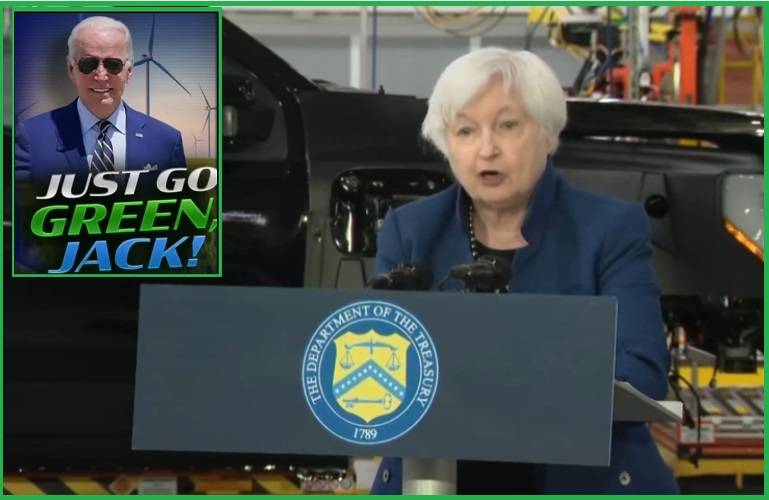Collapse is never a sudden occurrence; it is an outcome of gradual erosion over time. A weakening that takes place almost invisible to those who pass through the construct, until eventually, at an uneventful time in the mechanics of history, the process gives way.
Fitch has joined with the prior position of Standard & Poors to downgrade the USA credit rating. The weight of debt, in combination with reverberations from the continued hammering deep inside the political fundamental change operation, has triggered another flare.
In the bigger picture, this is a self-fulfilling prophecy driven by the latest focus on unsustainable economic policy, aka The Green New Deal. The efforts of the fiscal, monetary and economic policy are all aligned to shrink the U.S. economy, thereby creating the era of “sustainable energy” a possibility. Unfortunately, this is akin to a household intentionally shrinking their income while at the same time taking on credit card debt. The process itself is not sustainable.
(Reuters) – Rating agency Fitch on Tuesday downgraded the U.S. government’s top credit rating, a move that drew an angry response from the White House and surprised investors, coming despite the resolution of the debt ceiling crisis two months ago.
Traders’ immediate response was to embark on a safe-haven push out of stocks and into government bonds and the dollar.
Fitch downgraded the United States to AA+ from AAA, citing fiscal deterioration over the next three years and repeated down-the-wire debt ceiling negotiations that threaten the government’s ability to pay its bills.
[…] “In Fitch’s view, there has been a steady deterioration in standards of governance over the last 20 years, including on fiscal and debt matters, notwithstanding the June bipartisan agreement to suspend the debt limit until January 2025,” the rating agency said in a statement.
U.S. Treasury Secretary Janet Yellen disagreed with Fitch’s downgrade, in a statement that called it “arbitrary and based on outdated data.”
[…] In a previous debt ceiling crisis in 2011, Standard & Poor’s cut the top “AAA” rating by one notch a few days after a debt ceiling deal, citing political polarization and insufficient steps to right the nation’s fiscal outlook. Its rating is still “AA-plus” – its second highest.
After that downgrade, U.S. stocks tumbled and the impact of the rating cut was felt across global stock markets, which were in the throes of the euro zone financial meltdown.
In May, Fitch had placed its “AAA” rating of U.S. sovereign debt on watch for a possible downgrade, citing downside risks, including political brinkmanship and a growing debt burden. (read More)
What do Barack Obama and Joe Biden have in common? They were both in office, executing an identical economic, fiscal and monetary policy, when the USA credit was downgraded.


My local church is bursting at the seams and it was newly built 2 years ago. We are now adding an additional service on Saturdays. Hard times send people to church and our growth attests to that fact. I am old now and this growth is being fueled by young families and it gladdens my heart. On the other hand, I am fearful that our now not of the people, by the people, and for the people government will be instituting false emergencies to stop our gatherings at church just as they did during the CHINA VIRUS fraud pandemic. We must be stopped from congregating and discussing ideas that our government is corrupt.
How can any rating agency have any confidence in the U.S. with these morons in charge???
Lol, they can’t
FreedomWorks
@FreedomWorks
🤯 READ THE REPORT: “It was not about the debt ceiling fight. It clearly says, it’s because we provided no vision of what we were going to do about U.S. sovereign debt.”
@RepDavid
#ampFW
*****
Rep. David Schweikert
@RepDavid
Schumer conveniently ignores the primary reason for Fitch’s downgrade — we don’t take our debt seriously and continue to borrow at an unsustainable pace.
I’ve long warned about a credit downgrade due to reckless spending.
Cont…
Lauren Boebert
@laurenboebert
Fitch downgraded our AAA rating for the first time since 1994 and the fake news isn’t talking about it because of the third sham Trump indictment.
Fitch cited rising government deficits, significant increases to our general debt, rising interest rates, and they even projected a 4th quarter recession.
Stop your inflation policies and spending money we don’t have Joe!
11:57 AM · Aug 2, 2023
The Industrial Devolution can not be profitable and in a free market society would be repudiated by all.
Only an Autocratic government would actively support such idiocy.
Buy gold, silver, brass, and storable food.